Biomass and Nutrients Variation of Chinese Fir Rooted Cuttings under Conventional and Exponential Fertilization Regimes of Nitrogen
Abstract
:1. Introduction
2. Materials and Methods
2.1. Study Area
2.2. Experimental Design and N Fertilization Regimes
2.3. Plant Sampling and Chemical Analysis
2.3.1. Determination of Chlorophyll Fluorescence Parameters
2.3.2. Biomass Determination
2.3.3. Determination of Plant Nutrients
2.4. Data Processing
3. Results
3.1. Effects of Different Fertilization Levels on the Height and Ground Diameter of Chinese Fir Rooted Cuttings
3.2. Effects of Different Fertilization Treatments on the Biomass of Chinese Fir Seedlings
3.3. Effects of Different Fertilization on the Characteristics of Chlorophyll Fluorescence Parameters of Chinese Fir Seedlings
3.4. Effects of Different Fertilization Levels on Nutrient Contents of Chinese Fir Rooted Cuttings
4. Discussion
5. Conclusions
Author Contributions
Funding
Acknowledgments
Conflicts of Interest
References
- Sun, H.Y.; Liu, Y.; Ma, L.Y.; Jia, Z.K.; Kang, Y.Y.; Jin, H.F.; Jiang, H.; Liu, F.S.; Li, X.L. Effects of supplying of nitrogen phosphorus to Larix olgensis seedling quality. J. Inner Mongolia agri. Univ. 2011, 32, 58–62. (In Chinese) [Google Scholar]
- Hu, Y.L.; Hu, Y.; Zeng, D.H.; Xiao, T.; Chang, S.X. Exponential fertilization and plant competition effects on the growth and N nutrition of trembling aspen and white spruce seedlings. Can. J. For. Res. 2014, 45, 78–86. [Google Scholar] [CrossRef]
- Woods, P.; Nambiar, E.; Smethurst, P. Effect of annual weeds on water and nitrogen availability to Pinus radiata trees in a young plantation. For. Ecol. Manag. 1992, 48, 145–163. [Google Scholar] [CrossRef]
- Ervin, D.; Jussaume, R. Integrating social science into managing herbicide-resistant weeds and associated environmental impacts. Weed Sci. 2014, 62, 403–414. [Google Scholar] [CrossRef]
- Imo, M.; Timmer, V.R. Growth and nutritional interactions of nutrient-loaded black spruce seedlings with neighboring natural vegetation under greenhouse conditions. For. Sci. 2002, 48, 77–84. [Google Scholar]
- Malik, V.; Timmer, V.R. Interaction of nutrient-loaded black spruce seedlings with neighbouring vegetation in greenhouse environments. Can. J. For. Res. 1995, 25, 1017–1023. [Google Scholar] [CrossRef]
- Oliet, J.A.; Planelles, R.; Aptero, F.; Valverde, R.; Jacobs, D.; Segura, M.L. Field performance of Pinus halepensis planted in Mediterranean arid condition: Relative influence of seeding morphology and mineral nutrition. New For. 2009, 37, 313–331. [Google Scholar] [CrossRef]
- Hawkins, B.J.; Burgess, D.; Mitchell, A.K. Growth and nutrient dynamics of western hemlock with conventional or exponential greenhouse fertilization and planting in different fertility conditions. Can. J. For. Res. 2005, 35, 1002–1016. [Google Scholar] [CrossRef]
- Timmer, V.R. Exponential nutrient loading: A new fertilization technique to improve seedlings performance on competitive sites. New For. 1996, 13, 275–295. [Google Scholar]
- Salifu, K.F.; Jacobs, D.F.; Birge, Z.K. Nursery nitrogen loading improves field performance of bare root oak seedlings planted on abandoned mine lands. Restor. Ecol. 2009, 17, 339–349. [Google Scholar] [CrossRef]
- Li, Y.F.; Hu, S.D.; Chen, J.H.; Muller, K.; Li, Y.C.; Fu, W.J.; Lin, Z.W.; Wang, H.L. Effects of biochar application in forest ecosystems on soil properties and greenhouse gas emission: A review. J. Soils Sediments 2018, 18, 546–563. [Google Scholar] [CrossRef]
- Fu, W.J.; Fu, Z.J.; Ge, H.L.; Ji, B.Y.; Jiang, P.K.; Li, Y.F.; Wu, J.S.; Zhao, K.L. Spatial variation of biomass carbon density in a subtropical region of southeastern China. Forests 2015, 6, 1966–1981. [Google Scholar] [CrossRef]
- Wei, H.X.; Xu, C.Y.; Ma, L.Y.; Jiang, L.N. Advances in Study on Seedling Exponential Fertilization Regime. Sci. Silvae Sinicae 2010, 46, 140–146. (In Chinese) [Google Scholar]
- Malik, V.; Timmer, V.R. Biomass partitioning and nitrogen retranslocation in black spruce seedlings on competitive mixed wood sites: A bioassay study. Can. J. For. Res. 1998, 28, 206–215. [Google Scholar] [CrossRef]
- Salifu, K.F.; Timmer, V.R. Nitrogen retranslocation response of young Picea mariana to nitrogen-15 supply. Soil Sci. Soc. Am. J. 2003, 67, 309–318. [Google Scholar]
- McAlister, J.A.; Timmer, V.R. Nutrient enrichment of white spruce seedlings during nursery culture and initial plantation establishment. Tree Physiol. 1998, 18, 195–202. [Google Scholar] [CrossRef] [PubMed] [Green Version]
- Fu, W.J.; Fu, Z.J.; Zhao, K.L.; Tunney, H.; Zhang, C.S. Variation of soil P and other nutrients in a long-term grazed grassland P experiment field. Arch. Agron. Soil Sci. 2014, 60, 1459–1466. [Google Scholar] [CrossRef]
- Everett, K.T.; Hawkins, B.J.; Kiiskila, S. Growth and nutrient dynamics of Douglas-fir seedlings raised with exponential or conventional fertilization and planted with or without fertilizer. Can. J. For. Res. 2007, 37, 2552–2562. [Google Scholar] [CrossRef]
- Jia, H.J.; Ingestad, T.A. Study on optimum nutrient trqurements of Paulownia elongata and Robinia pseudoacacia seedlings. Sci. Silvae Sin. 1989, 25, 1–6. (In Chinese) [Google Scholar]
- Dai, W.; Fu, W.J.; Jiang, P.K.; Zhao, K.L.; Li, Y.H.; Tao, J.X. Spatial pattern of carbon stocks in forest ecosystems of a typical subtropical region of southeastern China. Forest Ecol. Mang. 2018, 409, 288–297. [Google Scholar] [CrossRef]
- Yu, Z.Y.; Dong, J.Q.; Fu, W.J.; Ye, Z.Q.; Li, W.Y.; Zhao, K.L. The transfer characteristics of potentially toxic trace elements in different soil-rice systems and their quantitative models in southeastern China. Int. J. Environ. Res. Public Health 2019, 16, 2503. [Google Scholar] [CrossRef]
- Fang, X.H.; Zhang, J.C.; Meng, M.J.; Guo, X.P.; Wu, W.Y.; Liu, X.M.; Zhao, K.L.; Ding, L.Z.; Shao, Y.F.; Fu, W.J. Forest-type shift and subsequent intensive management affected soil organic carbon and microbial community in southeastern China. Eur. J. For. Res. 2017, 136, 689–697. [Google Scholar] [CrossRef]
- Wang, L.P.; Yan, Z.Y.; Li, J.Y.; Wang, J.H.; He, X.; Su, Y.; Chen, B.; Ma, J.W.; Dong, J.L. Effects of exponential fertilization on biomass allocation and root morphology of Catalpa bungei clones. Acta Ecol. Sin. 2012, 32, 7452–7462. (In Chinese) [Google Scholar] [CrossRef]
- Chen, Q.T. Comparison test and repeatability estimates on Cunninghamia lanceolata clones afforestation. For. Inventory Plann 2012, 35, 140–144. (In Chinese) [Google Scholar]
- Wu., W.F.; Lin, H.P.; Fu, W.J.; Penttinen, P.; Li, Y.F.; Jin, J.; Zhao, K.L.; Wu, J.S. Soil organic carbon content and microbial functional diversity were lower in monospecific Chinese hickory stands than in natural Chinese hickory-broad-leaved mixed forests. Forests 2019, 10, 357. [Google Scholar] [CrossRef]
- Fu, W.J.; Jiang, P.K.; Zhao, K.L.; Zhou, G.M.; Li, Y.F.; Wu, J.S.; Du, H.Q. The carbon storage in Moso Bamboo plantation and its spatial variation in Anji County of southeastern China. J. Soils Sediments 2014, 14, 320–329. [Google Scholar] [CrossRef]
- World Reference Base for Soil Resources (WRB). A Framework for International Classification, Correlation and Communication; Food and Agriculture Organization of the United Nations: Rome, Italy, 2006. [Google Scholar]
- Ingestad, T.; Lund, A. Nitrogen stress in birch seedling: Growth technique and growth. Physiol. Plant. 1979, 45, 137–148. [Google Scholar] [CrossRef]
- Fu, W.J.; Zhao, K.L.; Zhang, C.S.; Wu, J.S.; Tunney, H. Outlier identification of soil phosphorus and its implication for spatial structure modeling. Precis. Agric. 2016, 17, 121–135. [Google Scholar] [CrossRef]
- Zhao, K.L.; Fu, W.J.; Qiu, Q.Z.; Ye, Z.Q.; Li, Y.F.; Tunney, H.; Dou, C.Y.; Zhou, K.N.; Qian, X.B. Spatial patterns of potentially hazardous metals in paddy soils in a typical electrical waste dismantling area and their pollution characteristics. Geoderma 2019, 337, 453–462. [Google Scholar] [CrossRef]
- Fu, W.J.; Tunney, H.; Zhang, C.S. Spatial variation of soil nutrients in a dairy farm and its implications for site-specific fertilizer application. Soil Till. Res. 2010, 106, 185–193. [Google Scholar] [CrossRef]
- Dai, W.; Zhao, K.L.; Fu, W.J.; Jiang, P.K.; Li, Y.F.; Zhang, C.S.; Gielen, G.; Gong, X.; Li, Y.H.; Wang, H.L.; et al. Spatial variation of organic carbon density in topsoils of a typical subtropical forest, southeastern China. Catena 2018, 167, 181–189. [Google Scholar] [CrossRef]
- Fu, W.J.; Zhao, K.L.; Tunney, H.; Zhang, C.S. Using Moran’s I and geostatistics to identify spatial patterns of soil nutrients in two different long-term phosphorus application plots. J. Plant Nutr. Soil Sci. 2011, 174, 785–798. [Google Scholar] [CrossRef]
- Wang, R.; Li, J.Y.; Zhang, F.Q.; Zhu, B.Z.; Pan, W. Growing dynamic root system of Aquilaria malaccensis and Aquilaria sinensis seedlings in response to different fertilizing methods. Acta Ecol. Sin. 2011, 31, 98–106. (In Chinese) [Google Scholar]
- Hao, L.F.; Wang, Q.C.; Zhang, Y.D.; Xu, Q.X.; Peng, H.M.; Liu, T.Y. Effect of exponential fertilization on biomass and nutrient dynamics of Padus maackii seedlings. Sci. Silv. Sin. 2012, 48, 33–39. (In Chinese) [Google Scholar]
- Liu, Z.H.; Liu, Y.; Duan, S.S. Effects of fertilization methods on seedling growth and drought tolerance of Platycladus orientalisunder different water conditions. J. Beijing For. Univ. 2002, 24, 56–60. (In Chinese) [Google Scholar]
- Dai, W.; Li, Y.; Fu, W.; Jiang, P.; Zhao, K.; Li, Y.; Penttinen, P. Spatial variability of soil nutrients in forest areas: A case study from subtropical China. J. Plant Nutr. Soil Sci. 2018, 181, 827–835. [Google Scholar] [CrossRef]
- Fu, W.J.; Zhao, K.L.; Zhang, C.S.; Tunney, H. Using GIS and geostatistics to optimize soil phosphor and magnesium sampling in temperate grassland. Soil Sci. 2013, 178, 240–247. [Google Scholar] [CrossRef]
- Fu, W.J.; Jiang, P.K.; Zhou, G.M.; Zhao, K.L. Using Moran’s I and GIS to study spatial pattern of forest litter carbon density in typical subtropical region, China. Biogeosciences 2014, 11, 2401–2409. [Google Scholar] [CrossRef]
- Yu, S.Y.; Chen, Z.L.; Zhao, K.L.; Ye, Z.Q.; Zhang, L.Y.; Dong, J.Q.; Shao, Y.F.; Zhang, C.S.; Fu, W.J. Spatial Patterns of Potentially Hazardous Metals in Soils of Lin’an City, Southeastern China. Int. J. Environ. Res. Public Health 2019, 16, 246. [Google Scholar] [CrossRef]
- Wen, G.S.; Tian, H.T.; Zhang, M.R.; Jiang, W.W. Application of chlorophyll fluorescence analysis in forest tree cultivation. Chin. J. Appl. Ecol. 2006, 17, 1973–1977. (In Chinese) [Google Scholar]
- Zhao, K.L.; Fu, W.J.; Ye, Z.Q.; Zhang, C.S. Contamination and spatial variation of heavy metals in the soil-rice system in Nanxun county, southeastern China. Int. J. Environ. Res. Public Health 2015, 12, 1577–1594. [Google Scholar] [CrossRef] [PubMed]
- Xu, X.J.; Timmer, V.R. Biomass and nutrient dynamics of Chinese fir seedlings under conventional and exponential fertilization regimes. Plant Soil 1998, 203, 313–322. [Google Scholar] [CrossRef]
- Timmer, V.R.; Armstrong, G. Growth and nutrition of Pinus resinosa seedlings at exponentially increasing nutrient additions. Can. J. For. Res. 1987, 17, 644–647. [Google Scholar] [CrossRef]
- Timmer, V.R.; Munson, A.D. Site-specific growth and nutrient uptake of planted Picea mariana in the Ontario Clay Belt. IV. Nitrogen loading response. Can. J. For. Res. 1991, 21, 1058–1065. [Google Scholar] [CrossRef]
- Boivin, J.R.; Miller, B.D.; Timmer, V.R. Later season fertilization of Picea mariana seedlings under greenhouse culture: Biomass and nutrient dynamics. Ann. For. Sci. 2002, 59, 255–264. [Google Scholar] [CrossRef]
- Zhang, W.F.; Gou, L.; Wang, Z.L.; Li, S.K.; Yu, S.L.; Cao, L.P. Effect of nitrogen on chlorophyll fluorescence of leaves of high-yielding cotton in Xinjiang. Sci. Agric. Sin. 2003, 36, 893–898. (In Chinese) [Google Scholar]
- Xu, J.K.; Chen, W.; Wang, J.; Fei, X.H. Effects of different fertilization strategies on growth and nutrition characteristics of Machilus thunbergii. Chin. J. Ecol. 2015, 34, 1241–1245. (In Chinese) [Google Scholar]
- Salifu, K.F.; Timmet, V. Optimizing nitrogen loading of Picea mariana seedlings during nursery culture. Can. J. For. Res. 2003, 33, 1287–1294. [Google Scholar] [CrossRef]
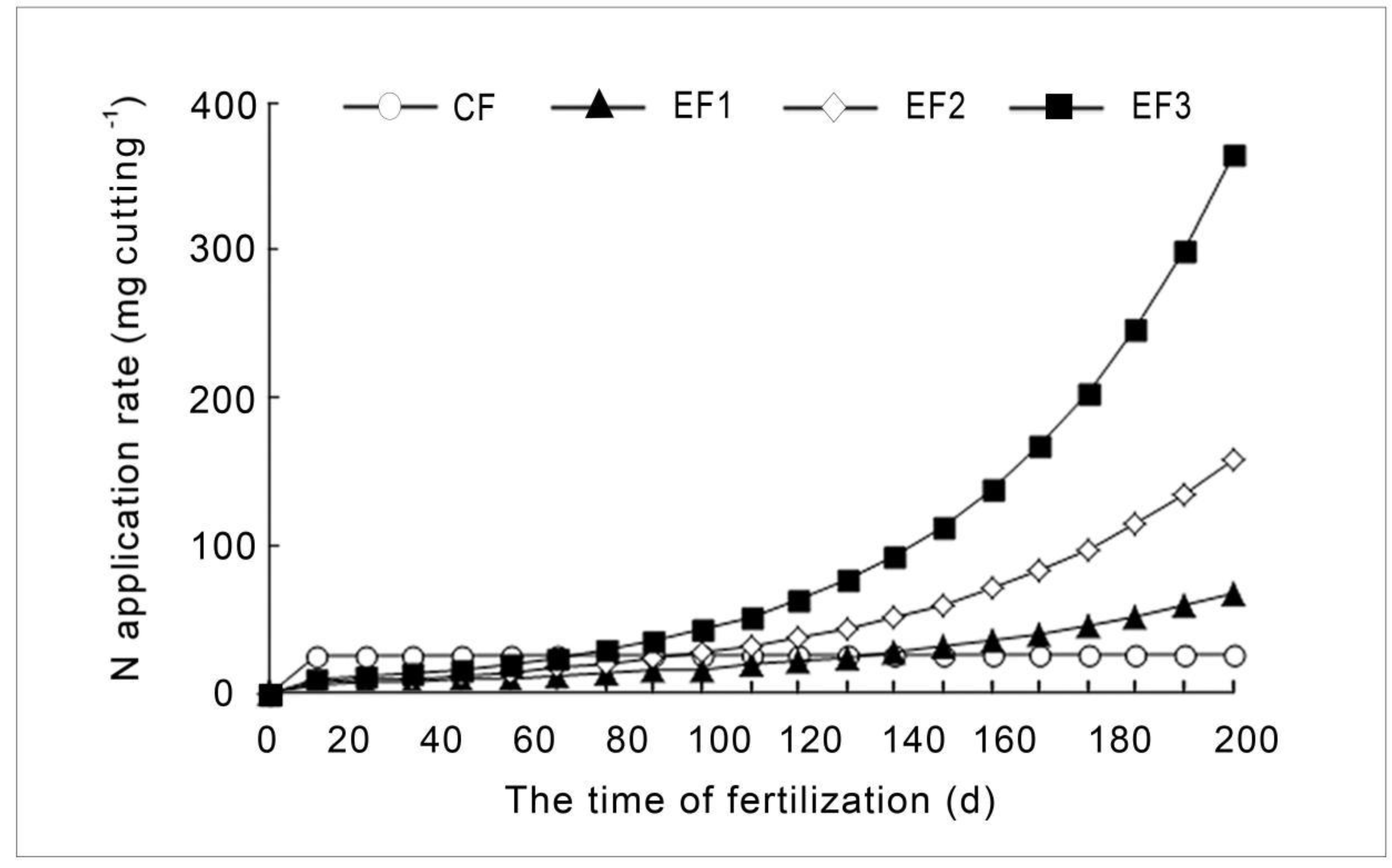
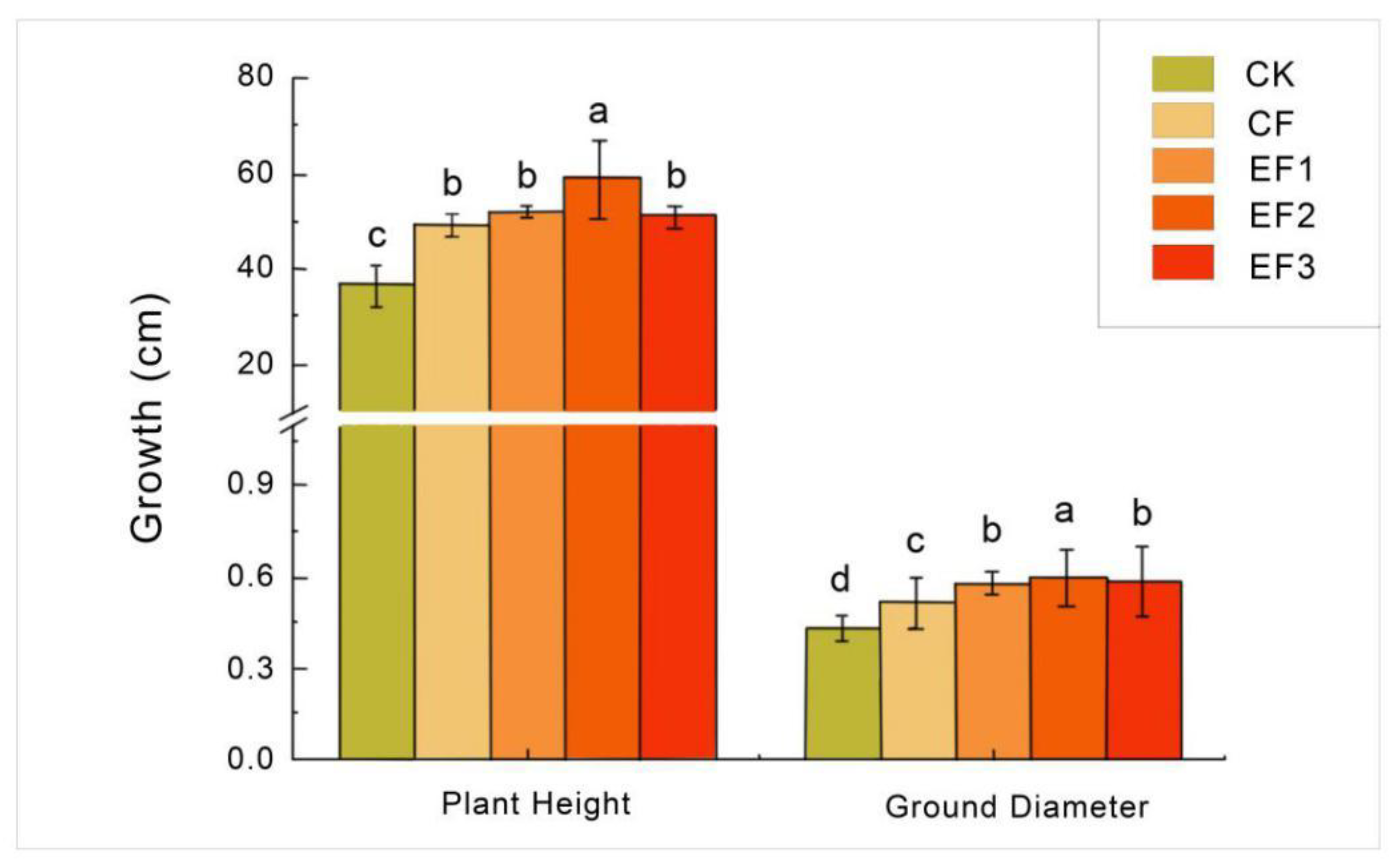
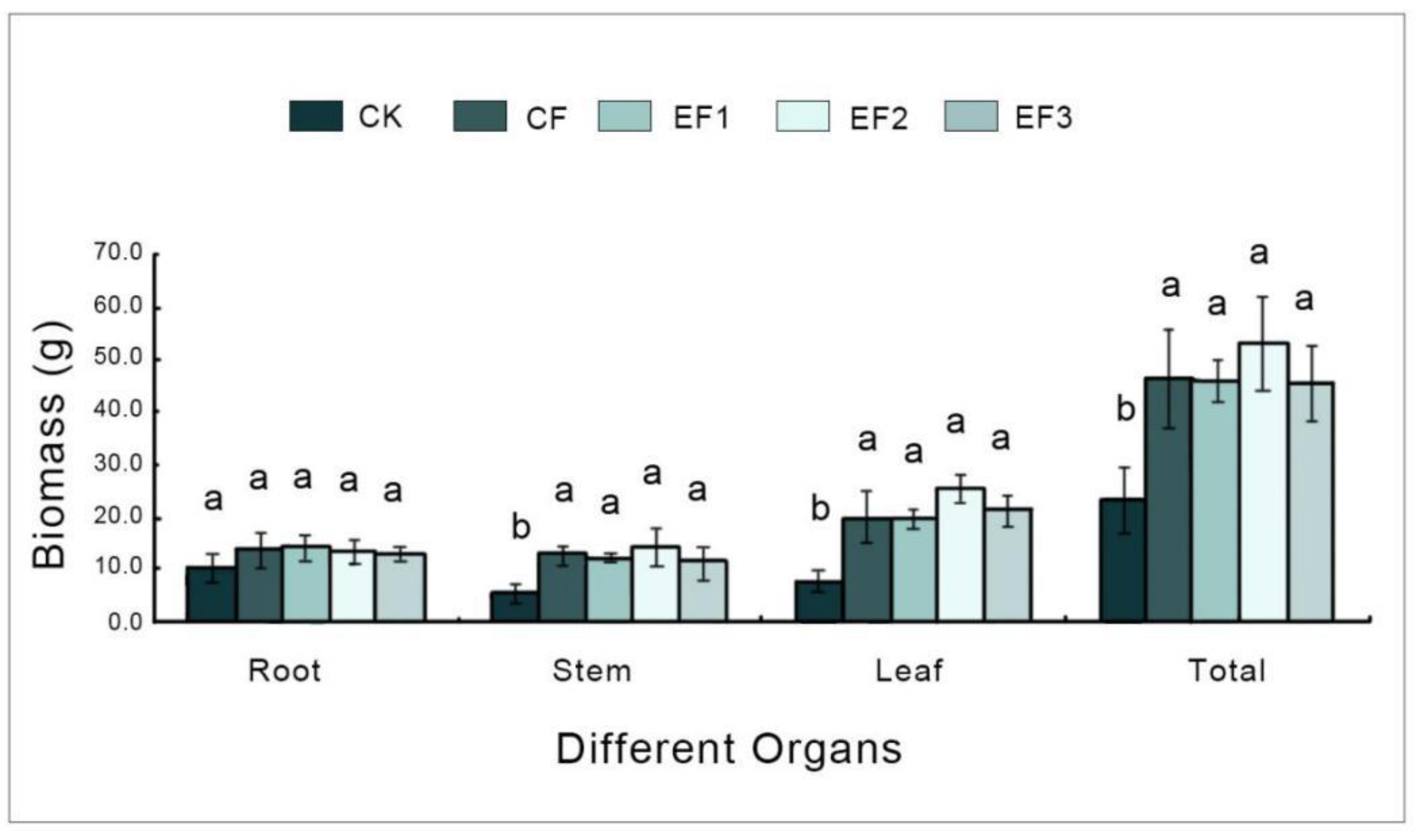
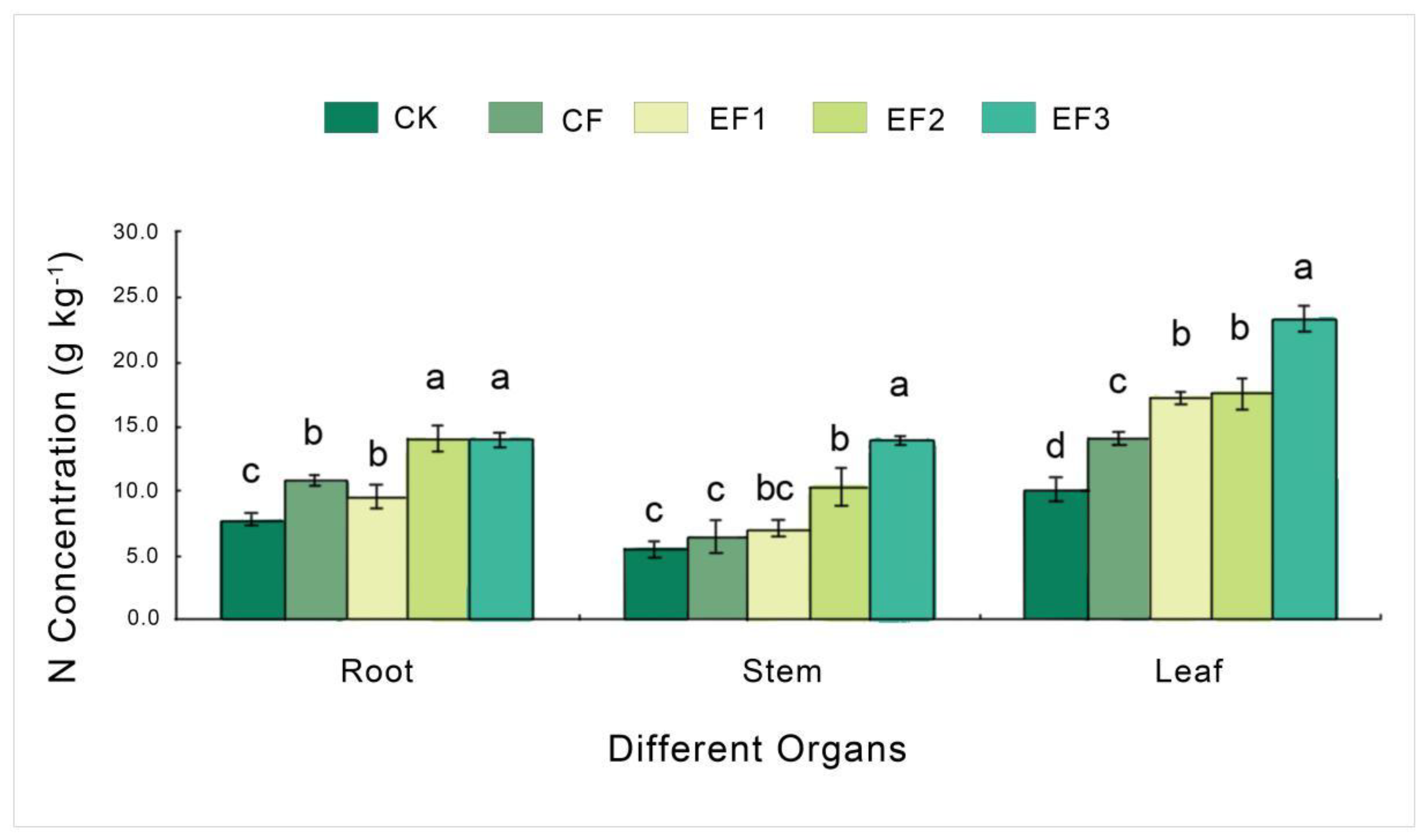
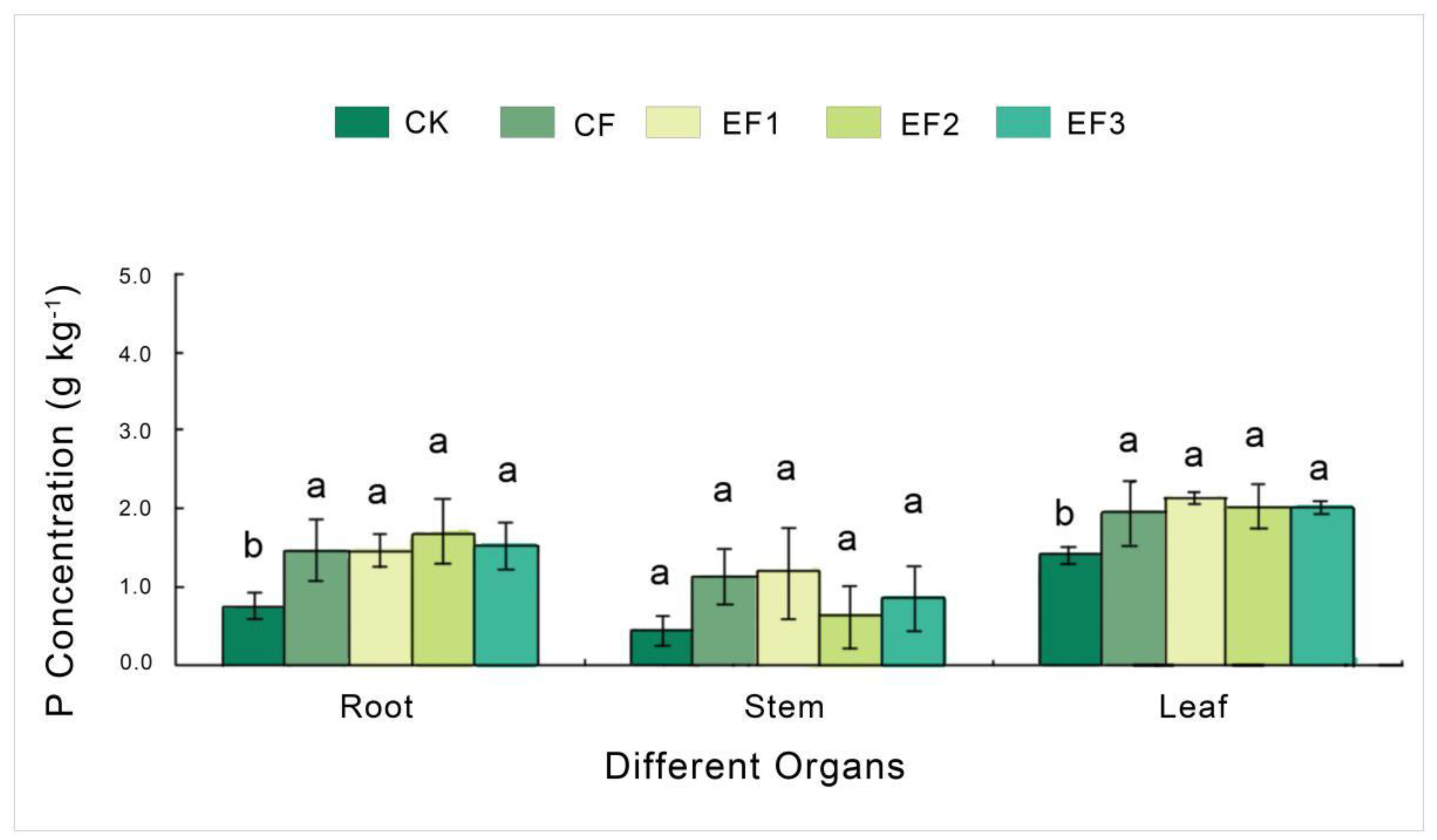
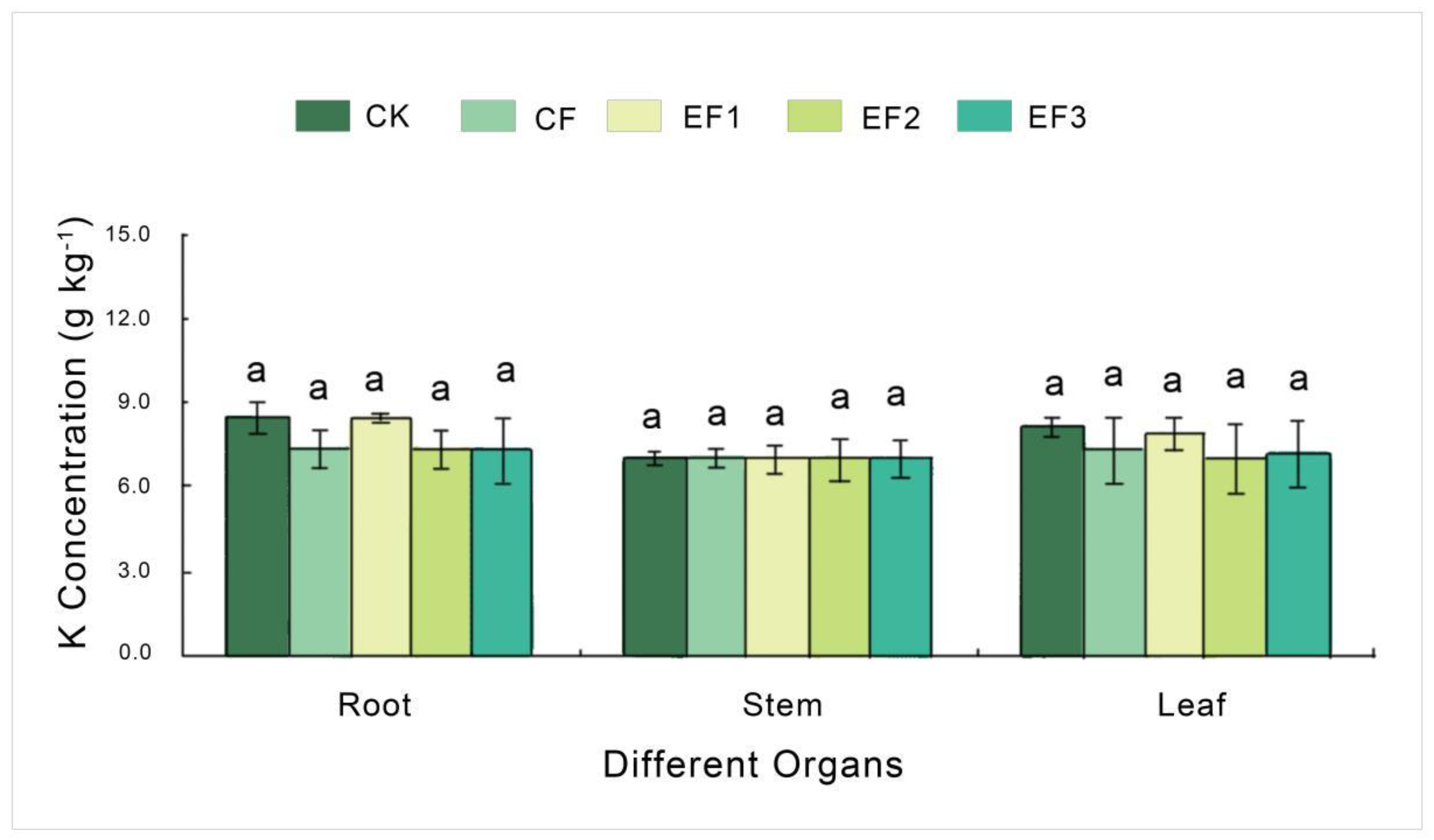
| CK | CF | EF1 | EF2 | EF3 | |
|---|---|---|---|---|---|
| Aboveground biomass/Belowground biomass | 0.76 ± 0.05 c | 1.44 ± 0.11 b | 1.40 ± 0.12 b | 1.90 ± 0.17 a | 1.67 ± 0.13 ab |
| Fertilization Treatments | QP | ETR | Yield |
|---|---|---|---|
| CK | 0.79 ± 0.00 c | 32.53 ± 0.19 d | 0.65 ± 0.00 c |
| CF | 0.88 ± 0.02 ab | 32.70 ± 0.37 d | 0.66 ± 0.01 bc |
| EF1 | 0.85 ± 0.012 b | 33.72 ± 0.07 c | 0.67 ± 0.00 b |
| EF2 | 0.89 ± 0.10 a | 35.79 ± 0.16 a | 0.71 ± 0.00 a |
| EF3 | 0.87 ± 0.01 ab | 35.13 ± 0.24 b | 0.70 ± 0.01 a |
© 2019 by the authors. Licensee MDPI, Basel, Switzerland. This article is an open access article distributed under the terms and conditions of the Creative Commons Attribution (CC BY) license (http://creativecommons.org/licenses/by/4.0/).
Share and Cite
Wu, J.; Lin, H.; Guo, L.; Dong, J.; Zhang, L.; Fu, W. Biomass and Nutrients Variation of Chinese Fir Rooted Cuttings under Conventional and Exponential Fertilization Regimes of Nitrogen. Forests 2019, 10, 615. https://doi.org/10.3390/f10080615
Wu J, Lin H, Guo L, Dong J, Zhang L, Fu W. Biomass and Nutrients Variation of Chinese Fir Rooted Cuttings under Conventional and Exponential Fertilization Regimes of Nitrogen. Forests. 2019; 10(8):615. https://doi.org/10.3390/f10080615
Chicago/Turabian StyleWu, Jiasen, Haiping Lin, Lianhua Guo, Jiaqi Dong, Luyao Zhang, and Weijun Fu. 2019. "Biomass and Nutrients Variation of Chinese Fir Rooted Cuttings under Conventional and Exponential Fertilization Regimes of Nitrogen" Forests 10, no. 8: 615. https://doi.org/10.3390/f10080615
APA StyleWu, J., Lin, H., Guo, L., Dong, J., Zhang, L., & Fu, W. (2019). Biomass and Nutrients Variation of Chinese Fir Rooted Cuttings under Conventional and Exponential Fertilization Regimes of Nitrogen. Forests, 10(8), 615. https://doi.org/10.3390/f10080615





